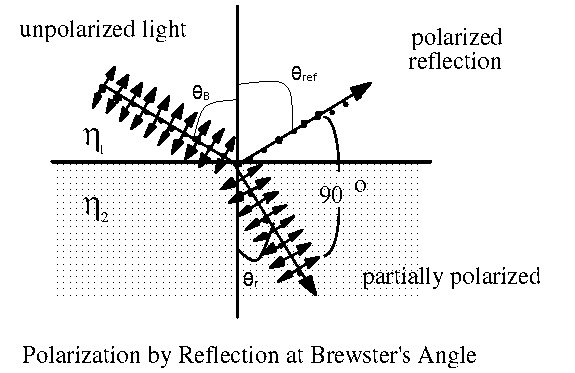Question
Question: State and prove Brewster’s law....
State and prove Brewster’s law.
Solution
Hint: Brewster’s law states that an unpolarized light ray gets polarized maximum when it falls at a certain angle of incidence, called the Brewster’s angle onto an interface of another medium. The reflected and refracted rays are perpendicular to each other. The reflected ray is completely polarized.
Formula used:
When light travels from a medium of optical density n1 to a medium of optical density n2, the angle of incidence θi is related to the angle of reflection θr by
n1sinθi=n2sinθr (Snell !!′!! s Law)
According to the laws of reflection, when light is reflected by a surface, the angle of incidence θi is equal to the angle of reflection θrefl. That is,
θi=θrefl
Complete step by step answer:
Brewster’s law is a statement that says that when unpolarized light falls on an interface, the reflected light is completely polarized if the angle of incidence is a specific angle called the Brewster’s angle. In this case the angle made by the refracted ray and the reflected ray is 900.
Let us draw a diagram to understand this better.

We will draw up a relation between the properties of the two media and the Brewster’s angle.
As shown in the figure, an unpolarized light ray falls on an interface between two media of respective optical densities η1 and η2 at the Brewster’s angle of incidence θB. The angle of reflection is θref and the angle of refraction is θr. The reflected and refracted ray are perpendicular to each other and the reflected ray is completely polarized in one direction.
Now, when light travels from a medium of optical density n1 to a medium of optical density n2, the angle of incidence θi is related to the angle of reflection θr by
n1sinθi=n2sinθr (Snell !!′!! s Law) ---(1)
According to the laws of reflection, when light is reflected by a surface, the angle of incidence θi is equal to the angle of reflection θrefl. That is,
θi=θrefl --(2)
Hence, using (1), we get,
η1sinθB=η2sinθr
∴sinθr=η2η1sinθB --(3)
From the figure’s geometry, we get,
θref+900+θr=1800 (Since, the angle of a straight line is 1800)
∴θref+θr=1800−900=900
∴θr=900−θref ---(4)
Now, according to (2),
θB=θref
∴θr=900−θB [Using (4)] --(5)
Using (3) and (5), we get,
sin(900−θB)=η2η1sinθB
∴cosθB=η2η1sinθB (∵sin(900−θ)=cosθ)
∴η1η2=cosθBsinθB=tanθB (∵cosθsinθ=tanθ)
∴η21=tanθB
where (η21=η1η2) is the refractive index of medium 2 with respect to medium 1.
∴θB=tan−1(η21)
Therefore, we have found a relation for the Brewster’s angle of incidence and the optical properties of the two media.
Note: Students must be familiar with the derivation of the brewster’s angle since it is very important and many theoretical as well as numerical questions are based upon this concept.
The glare of sunlight from the reflection of water is due to the polarized nature of the light reaching our eyes. If polarized sunglasses are used, the glare can be reduced since the polarized sunglasses only allow light of a certain polarization to enter and minimize the glare. This technology is the reason why authentic polarized sunglasses are so expensive.
